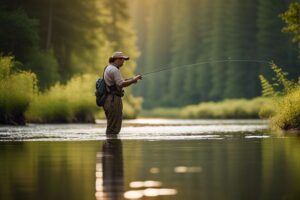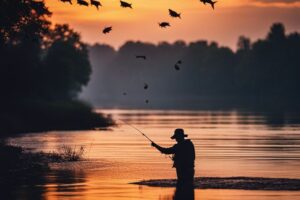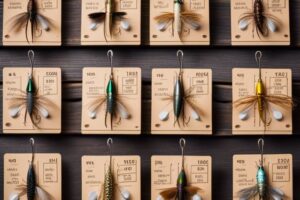You seek to improve your dry fly selection and catch more fish. Understanding the life cycles and habits of aquatic insects can guide your choices on the water. By honing your knowledge of entomology, you can match your flies more effectively to what the fish are feeding on at any given moment. This post will help you probe into the imperative insects you should know, making each cast count. Embrace the science beneath the surface, and your fishing will never be the same.
Insect Anatomy for Fly Fishers
External Features: Wings, Legs, and Body
The anatomy of an insect plays a critical role in understanding what you might encounter on the water. Wings can vary significantly among different species, affecting their life cycle and the imitative patterns you choose for your flies. For instance, mayflies possess delicate, membranous wings that they hold upright after emerging from the water, while caddisflies have more robust wings that can be rolled or folded, adding to the complexity of your dry fly selection. Observing these features helps you create more realistic imitations that fish will recognize and strike.
Legs are another imperative external feature. Insects are equipped with six legs, which aid in various activities like swimming, walking, and climbing onto vegetation. Different insects might have different leg structures tailored for their lifestyle; for instance, stoneflies with strong legs are adept at navigating swift currents. The body segment offers clues as well, with distinct shapes and colors revealing more about each insect’s habitat preference and the time they spend hatching. These subtle hints can sharpen your fly selection and improve your success rate.
Internal Features: Mouthparts and Digestive System
To attract fish effectively, understanding the internal features of insects becomes imperative. The mouthparts are particularly significant as they determine how an insect feeds. Different insects adapt their mouthparts for specific diets, such as sucking, chewing, or lapping. This diversity directly influences what you choose to imitate in your flies. For example, a mayfly’s delicate, siphoning mouthparts indicate a feeding style that is best matched with surface patterns, while a stonefly’s chewing mouthparts suggest a different approach when targeting those species.
Mouthparts vary greatly among insect groups, revealing much about their feeding habits and ecological roles. For example, a midge larva has a pair of tiny, hook-like mouthparts that allow it to scrape algae off rocks, while a caddisfly has a more versatile set suited for both scraping and chewing. By paying close attention to these features, you can make more informed decisions about which dry fly patterns will effectively mimic the local insect life, ensuring you are at your best come fishing season.
Life Cycles of Insects
If you’re looking to improve your dry fly selection, understanding the life cycles of insects is your key to success. Each stage plays a crucial role in the ecosystem and directly influences the behavior of fish. By familiarizing yourself with these stages, you can better match your flies to the naturals, giving you an advantage on the water. For an in-depth exploration, check out The Dry-fly Fisherman’s Entomology, which will enhance your knowledge and skills.
Egg Stage: Laying and Hatching
Any seasoned angler knows the importance of the egg stage in an insect’s life cycle. Female insects lay their eggs in specific environments that will best support the survival of their young. For aquatic insects, this often means laying eggs on the surface of the water or among vegetation where they can easily hatch into nymphs. The timing of this stage is crucial; many species align their hatching with optimal environmental conditions, such as water temperature and seasonal changes. Understanding when and where these eggs appear can give you insight into when to fish your patterns.
While eggs are usually hard to spot, knowing the typical habitats of certain insects can inform your fishing strategy. For example, if you identify a stream with a high concentration of mayfly eggs, you might consider using imitative patterns that mirror them. Fish are often opportunistic feeders and will be looking for these newly hatched insects, making your choice of dry flies crucial during this time.
Nymph Stage: Development and Behavior
Stage two in your insect journey reveals the nymph stage, which is vital for both anglers and aquatic ecosystems. Nymphs are water-dwelling immature forms of insects, and they spend a significant portion of their lives in this state. The development can take weeks to years, depending on the species and environmental conditions. During this time, nymphs undergo several molts, growing larger and developing more specialized features that prepare them for emergence into adulthood. Their behavior during this stage is important; nymphs often dart from the riverbed to avoid predators, which can inform your choice of presentation on the fly-fishing line.
This nymph stage provides a wealth of knowledge for fly fishers. By observing the movement and coloration of nymphs in your local waters, you can refine your fly selection. Emulating their natural behavior, such as adding subtle twitches or adjusting your retrieval technique, can entice even the most finicky fish. The nymph stage serves not only as a critical growth period for insects but also as a prime feeding opportunity for fish, making it a key element of your fishing approach.
Insect Habitat and Behavior
Any angler worth their salt knows that understanding the habitat and behavior of insects is vital for effective dry fly selection. The waters you fish, whether they be rivers, lakes, or ponds, are likely teeming with various forms of aquatic insects. These insects’ life cycles and behavior not only influence their populations but also dictate what they will look like in different seasons. Recognizing these patterns can dramatically elevate your success when you choose your next dry fly. Your ability to mimic these insects will make all the difference in attracting fish, particularly during hatches when the insects are most active.
Aquatic Insects: Rivers, Lakes, and Ponds
With each body of water comes a unique environment for aquatic insects. Rivers are often rich with fast-moving currents, which can influence the speed at which insects emerge and drift downstream. Conversely, lakes and ponds, with their still waters, create a different set of conditions where aquatic insects might spend longer periods in various life stages. This often leads you to find more diverse insect life in lakes, where slower currents allow insects like mayflies and caddisflies to thrive and develop. Pay attention to the type of water you fish in—it reveals much about which insects you can target with your flies.
Terrestrial Insects: Land-Dwelling and Flying
An equally crucial part of your dry fly selection process involves understanding terrestrial insects. These insects occupy various habitats, from gardens to forests, and their presence can significantly affect fish behavior, especially near the banks where feeding occurs. The time of year also determines which insects will be roaming about. During warmer months, you may notice a higher incidence of flying ants, beetles, and grasshoppers, all viable food sources for hungry fish. Recognizing these patterns allows you to prepare your dry fly arsenal effectively—matching the hatch as the saying goes—and increases your chances of a successful catch.
Flying insects, in particular, play a significant role in your fishing strategy. They often attract attention from fish feeding near the surface, especially on calm days when the water is like glass. Be observant of what types of terrestrial insects are prevalent at the time of your fishing trip and consider incorporating these into your fly selection. Use patterns that mimic these insects closely, whether it be a floating ant or a well-dressed hopper. The right choice here could make all the difference in eliciting strikes from fish that are paying attention to the feast above the water’s surface.
Identifying Insects for Dry Fly Fishing
Now that you’ve decided to enhance your dry fly fishing game, understanding the insects that may be hatching is crucial. You’ll find that having a solid grasp of entomology can dramatically improve your ability to select the right flies. To aid your exploration, consider investing in Entomology Aids. These tools can help you study the various life stages of insects, such as nymphs, emergers, and adults—each important depending on the time of year and conditions in your fishing area.
Visual Cues: Color, Shape, and Size
Color is one of the first visual cues you should look for when identifying insects on the water. Different species exhibit varying hues that can signal what is currently hatching. Observe your surroundings carefully; if you see small, pale mayflies on the surface, you may want to reach for a lighter-colored dry fly. Shape also plays a significant role. Flies can be elongated, round, or flat, and matching these profiles can make a difference in enticing fish. Size matters too—small mayflies and larger stoneflies require different-sized patterns in your box to effectively mimic their natural counterparts.
Behavioral Cues: Movement and Activity Patterns
Fishing also draws attention to behavioral cues. You should pay close attention to how insects move and interact with one another. Some mayflies, for example, tend to skitter across the surface before they take flight, while caddisflies may bounce in a more erratic manner. Understanding these patterns can help you anticipate what the fish are targeting at any given moment.
A keen observation of these behaviors not only assists in species identification but also allows for better timing of your casts. If you begin to notice a consistent pattern of activity, such as a hatch occurring in the early evening, you can plan your fishing sessions to coincide with these movements. This attentiveness can be the key to making the right decision at the right time and ultimately boosting your success on the water.
Insect Migration and Emergence Patterns
Your success as a dry fly fisher hinges not only on the patterns and colors of your flies but also on your understanding of insect behavior. Knowledge of insect migration and emergence patterns will allow you to choose the right flies at the right time. Pay attention to the rhythms of nature, for they hold the key to effective fishing. Each insect has its own cycle, influenced by daily and seasonal changes, which can impact your chance of success on the water.
Daily Cycles: Morning, Afternoon, and Evening
On the water, you will notice that insect activity often peaks during specific times of the day. Mornings are often marked by the gentle emergence of mayflies and caddisflies, stirring the surface to life. As the sun climbs higher, activity may slow down. However, in the afternoon, you might find a second wave of hatching. Terrestrials also begin to move, providing another opportunity. At dusk, prepare for a flurry as the day insects take their final dance. Understanding these rhythms can help you make critical decisions about which flies to use and when to present them.
Seasonal Cycles: Spring, Summer, Fall, and Winter
With the shifting seasons, the landscape of insects changes alongside. Spring awakens the waters, and with it, the flood of mayflies and stoneflies. Summer heats things up, bringing out a full cacophony of activity including caddis and beetles. In the fall, you might see a frenetic last push as insects complete their life cycles before winter sets in. Winter, though quieter, still presents opportunities with the right knowledge of what remains active. Each season presents unique challenges and openings, dictating how and when you should fish.
Afternoon fishing during the summer can be particularly fruitful. As the heat intensifies, certain hatches may occur, especially smaller mayflies that tend to come off quickly. Focus on the aquatic life that is active during the warmer days and adjust your fly selection accordingly. Observing how insects behave during these seasonal shifts will refine your approach and elevate your fishing experience, transforming random casts into deliberate strikes.
Matching the Hatch: Selecting the Right Fly
Keep your eyes peeled when you are on the water. Observing insect activity is crucial for selecting the right dry fly. Pay attention to the time of day, the weather conditions, and the types of insects that are active. Each season brings a different array of insects, and the time of day can impact their visibility. For example, mayflies are often most active during the late afternoon. Watching for surface rises can also provide clues. Look closely to see if fish are targeting specific insects or if they are indiscriminately feeding. These observations will guide you to the right choice when it comes time to cast your line.
Observing Insect Activity: What to Look For
Matching the insects on the water to the flies in your fly box is an art, and it starts with keen observation. Check for the size, shape, and color of the insects you see. Are they small, pale, and delicate, or are they larger and darker? If you are unsure, try gently catching a few insects and inspecting them closely. Additionally, watch for mating activity, emergence, or drifting insects, as these can indicate what your fly should imitate. The more attention you give to these details, the more likely you are to connect with feeding fish.
Choosing the Right Fly Pattern and Size
Size is an crucial factor in fly selection. Fish can be highly selective, so matching the size of the fly to the natural insects is critical. A fly that is too large or too small can signal to the fish that something is off, while a closely matched fly can entice even the most wary fish. Take note of the insects visible on the water and choose your fly size accordingly. If you observe larger mayflies, for instance, opt for a size that closely resembles them. Similarly, smaller hatches, like blue-winged olives, may require a downsized fly to be effective.
It is also important to consider the wing shape and profile of your fly. Different insects have distinct physical characteristics, and replicating these features can make all the difference. Flat-winged flies may work better for mayflies, while down-winged patterns may be more effective for caddisflies. Therefore, not only should you focus on size, but also on the specific patterns that correspond to the life stages of the insects you observe. Understanding these nuances will sharpen your approach and elevate your success on the water.
Final Words
As a reminder, understanding the intricacies of entomology is necessary for you as a dry fly fisher. The more you learn about the life cycles and behaviors of aquatic insects, the better equipped you become to replicate their presence on the water. This knowledge not only sharpens your fly selection but also enhances your ability to predict when and where fish will be feeding. With patience and observance, you can fine-tune your approach and increase your success in enticing those elusive strikes.
In the end, your journey with entomology does not have to be an overwhelming one. Start small, observe closely, and let your experiences guide you. Each outing offers valuable lessons to refine your skills. By integrating the study of insects into your fishing routine, you are not just casting a line; you are engaging with nature in a profound way. Embrace this partnership and let it deepen your connection to the waterways you love.
FAQ
Q: What is entomology, and why is it important for dry fly fishing?
A: Entomology is the scientific study of insects, which plays a crucial role in understanding the ecosystem of freshwater environments where dry fly fishing occurs. For anglers, knowledge of the life cycles, behaviors, and habitats of insects can significantly enhance fly selection. Different species of insects emerge at various times, and matching your dry fly to the natural insect population increases the likelihood of attracting fish. By understanding entomology, fishers can identify which insects are hatching and adjust their tactics accordingly.
Q: How can I identify the local insect species to improve my dry fly selection?
A: To effectively identify local insect species, start by observing your fishing environment closely. Look for insects around the water’s surface, on vegetation, and in the air during your outings. You may also consider using a field guide to aquatic insects or engaging with local fishing clubs for resources and knowledge sharing. Additionally, maintaining a fishing journal that includes notes on weather conditions, water temperature, and the insects observed can help establish patterns that improve your fly selection. Resources like online databases and nature apps can also assist in identifying species based on pictures and descriptions.
Q: What are the key stages of insect life cycles that dry fly fishers should know?
A: Understanding the key stages of insect life cycles is vital for dry fly fishers. Most aquatic insects go through four primary stages: egg, nymph (or larva), pupa, and adult. The adult stage is crucial for dry fly fishing since this is when the insects emerge and become vulnerable to fish predation. Pay particular attention to the timing of these stages, which can vary by season and local conditions. For instance, mayflies typically hatch in the spring, while caddisflies may be more prevalent in summer. Matching your dry flies to the specific life stage that is active will significantly increase your chances of success on the water.


